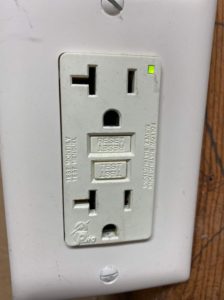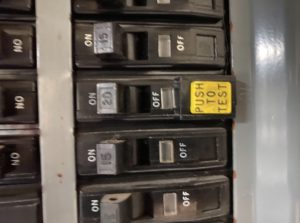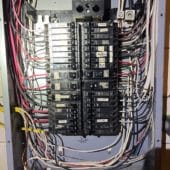A ground fault circuit interrupter or GFCI, is an electrical device that is installed to reduce the chances of electrocution or injury. GFCI may also be referred to as a GFI, or ground fault interrupter. These devices are relatively inexpensive and are one of the most important safety items in a modern day home. During a home inspection, a home inspector should seek to identify that GFCI’s exist in a home. Read on to learn more about how GFCI’s work and some common places they are found in a home.
How does the GFCI work?
GFCI devices work by constantly monitoring the current flowing in a circuit. If the flow of current going out is different the flow coming back the device interrupts the flow of current. The device can pick up differences as little as .006 amperes. Should a wire inside a tool touch the metal case of the tool, then the case of the tool would become charged with electricity. If you were touching the tool you could become the pathway for the electricity to travel. If the tool was plugged into a GFCI outlet, the power would be shut off before a potentially fatal shock could occur.
Common GFCI’s
There are two types of GFCI’s found in homes. The first is the common GFCI installed at a receptacle. The second type of GFCI is the circuit breaker variety. Both types of GFCI’s can be used to make an electrical system safer.

The receptacle GFCI is the common safety device most homeowners are familiar with. These can be found at many home improvement centers for around fifteen to twenty dollars. They are simple for many to install and are easily identified by seeing the “test” and “reset” buttons on the face of the device. They are used in place of a standard duplex receptacle and usually will fit in a standard outlet box. The GFCI device will protect against ground faults at the point of use but also in other outlets down stream in the branch circuit.


The circuit breaker GFCI is found at the electrical service panel. It can protect an entire circuit with ground fault protection. These breakers can be found at home improvement centers for around forty dollars. It’s important to make sure the brand of the breaker will fit properly. Panel manufacturers only allow specific types of breaker to be used with their panels for warranty and safety reasons. Most homeowner elect to have a qualified electrician install or replace these devices. In order to work safely, the electricity should be turned off before work is started. Working with electricity is dangerous and a homeowner should seek the assistance of a qualified electrical contractor when needed.
Common Areas for GFCI’s
Common areas for GFCI’s include outdoor receptacles, bathrooms, garages, kitchens, crawlspaces, unfinished basements, wet bar sink areas, and laundry and utility sinks. Portable GFCI’s are often found on construction job sites. These devices are typically extension cords with a safety device built into the cord.
GFCI Testing
GFCI’s should be tested after installation, a minimum of once per month, and/or per manufacturers instructions. At a receptacle, you simply press the test button. After pressing the button you should hear a click. So by pressing the reset button, the receptacle will then be able to power devices plugged into it. For a circuit breaker GFCI, simply press the button on the breaker to allow it to trip the breaker. To reset, flip the switch on the breaker. If you feel your GFCI device is malfunctioning or improper, you should seek the assistance of a qualified electrical contractor. In addition, testing may be done by a plug in electrical tester that has a GFCI test button. However, the proper method according to most manufacturers is by testing the GFCI by pressing the button at the receptacle or breaker.

The consumer product safety commission is a great resource for all homeowners regarding electrical safety products as well as other items in a home. Another great resource is the Lask Inspection Group, LLC in Rockford, Illinois. As a licensed and certified home inspection firm, Lask Inspection Group, LLC can be your ally when you are purchasing a new home. Call our firm today 815-978-7785 to schedule your next home inspection.

